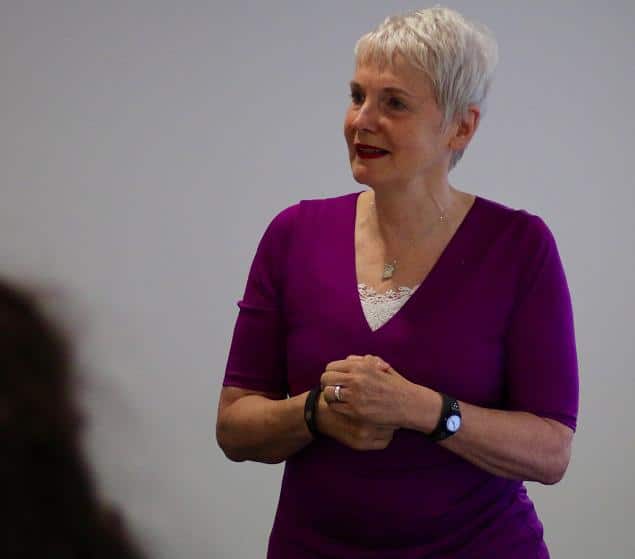
Understanding the learning of sign languages may enhance our understanding of the learning of spoken languages – Anne Baker
Photo: Christoff Pauw
“Fully understanding language acquisition in sign languages can challenge some of our theories of spoken language acquisition, and means that we may have to adapt the theories and models,” said Anne Baker, Emeritus Professor of Sign Linguistics at the University of Amsterdam and Professor Extraordinary for Sign Linguistics at Stellenbosch University. Dr Baker was presenting work from the Amsterdam database at a STIAS Fellows seminar, based on a study which followed sign language acquisition in cohorts of children from the age of six months since 1990.
Although we know signing was used routinely at least as far back as the Greek civilisation, there remain some common misunderstandings about sign languages which Dr Baker addressed. “Sign languages are not pantomime and there is no universal sign language – this is a common misunderstanding – a sign language emerges naturally within a deaf community,” she said.
“Sign languages are also not derived from spoken languages. Each sign language is codified and has its own rules and conventions, its own grammar and a complex lexicon,” she added. “There can be different sign languages within the same country.”
“These sign languages are not mutually intelligible,” she continued. “However, deaf people using different sign languages will adapt their signing more quickly than two people speaking different spoken languages. They look for shared meaning.”
Sign languages vary in how much they are used in different domains. “Once a sign language has official government recognition in a country, it enters different domains (like the Courts, for example) and then institutions may be tasked with developing specific, new vocabulary. New vocabulary tends to first be spelled manually until a sign has emerged but it is a process that comes from the community.”
Shared milestones
Understanding the milestones in sign language acquisition provides important information. “Babies (hearing and deaf) seem to be able to produce manual signs before they can produce spoken words. We need to understand if this is true and what it means,” said Dr Baker. “In babies the first signs usually appear around eight or nine months but this is probably connected to motor control of the arm muscles developing sooner than the finer motor skills required for speech.”
In her work she has not found evidence that sign languages are the earliest language acquired. “Patterns of dominance from the mouth or hand have also not been found,” she said. “There appear to be similar stages and timing to development in a spoken language – including the acquisition of multi-sign combinations from about the age of two years.” Children seem to learn to distinguish features and phonological parameters (like handshape, place of articulation, movement and orientation – all of which change meaning) at similar stages to those at which they distinguish sound categories.
Of course, learning a sign language also requires a different form of visual attention. The signs have to be visually accessible and adults talking to deaf children use various attention strategies to ensure the child sees the signing. The child has to learn to give visual attention to the signing adult and can perceive around 80% of his/her signs by age three. “There is a complex visual attention pattern,” said Dr Baker. “This is something that hearing parents with deaf children often find hard and it usually needs training. The attention factor needs to be included in models of sign language acquisition, but also of spoken language acquisition.”
Dr Baker also considered whether iconicity (the relationship between meaning and form) in signing helps learners. Iconicity is found in about 60% of signs and occurs in spoken languages too. “We have found that deaf children don’t necessarily make their early signs more iconic probably because their world view and knowledge is limited, so iconicity does not seem to help them,” she said. “However, hearing non-signing children learn iconic signs better and adult second-language sign language users rely heavily on iconicity.”
A unique feature of sign languages is that they can be produced at the same time as speaking. “All deaf people are bilingual to a degree,” said Dr Baker, “therefore codemixing is to be expected.” However, the codemixing is more code-blending. Deaf mothers use a great deal of code-blending with their children. “Young children learning a sign language produce this code-blending but its form is affected by hearing status. The hearing children of deaf parents also code-blend – but in a different way to the deaf children,” she added.
Dr Baker pointed out that there are an estimated 600 000 users of South African sign language. “Six out of a thousand children in South Africa are born deaf as opposed to one in a thousand in Europe. This is due to a mix of factors including lack of genetic counselling, hygiene and childhood illnesses.
Cochlear implantation is also not common yet in South Africa mainly because of the financial burden but also because there is not generally accessible assistance and training. The role of South African Sign Language is therefore crucial.”
_________________________________________________________________________________
Dr Baker’s book The Linguistics of Sign Languages: an Introduction. Eds. Anne Baker, Beppie Van den Bogaerde, Roland Pfau, & Trude Schermer, will be published soon by the John Benjamins Publishing Company.
Dr Baker also provided the following link to the New Zealand sign language dictionary: nzsl.vuw.ac.nz.
